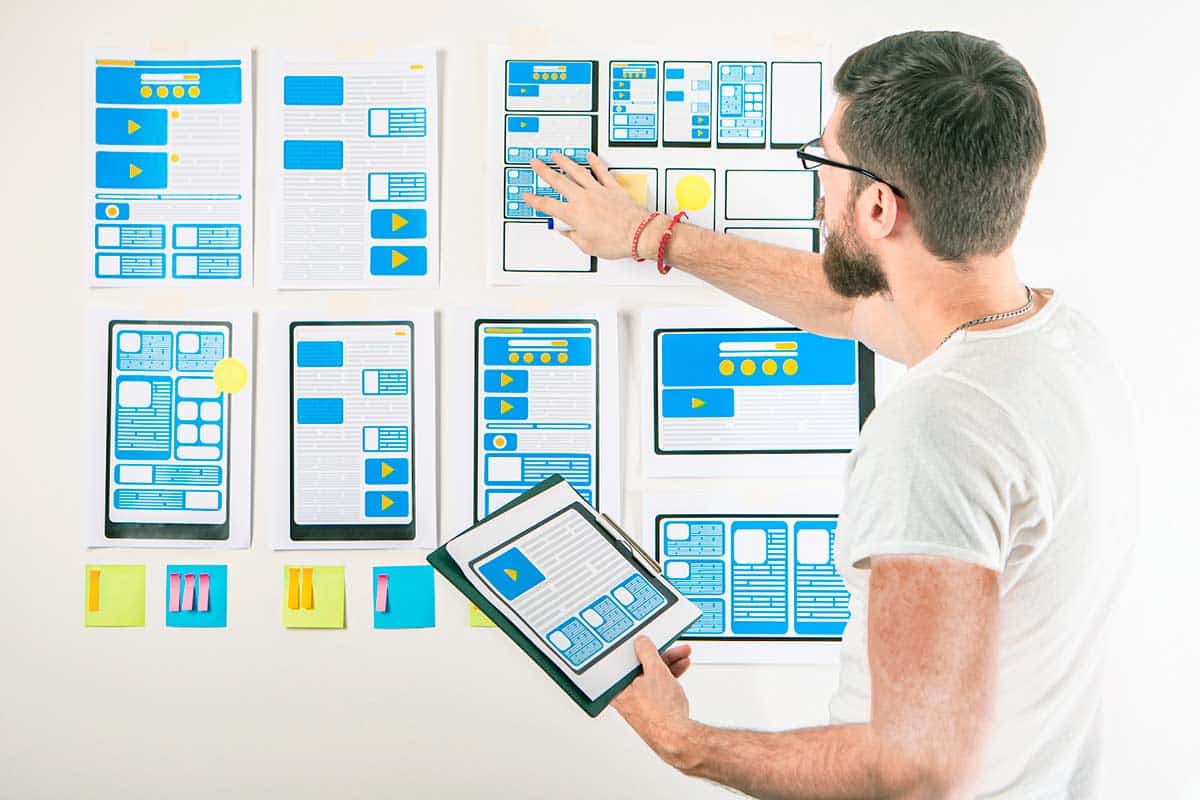Who is this Software Development Company information for?
There are two main situations in which this text is right for you.
Firstly, you have a promising idea or may have even started the development process but you are looking for a software development company to add extra expertise to your project and optimize your use of resources.
Secondly, you want to expand your knowledge of the software development process and services and learn about pitfalls so you know exactly how to bring your bright ideas to life when the time comes.
When you think about getting a development partner there are very certain issues you may have already faced or you can see yourself facing in the future. Here are some of them:
- What do I need extra experience/pair of hands with?
- How do I choose the right software development company?
- What impact on a final software product will I get?
That’s why we share our expertise in software product development life cycle (SDLC) and possible hidden dangers.
Why do I need to know about the software product development life cycle?
There is no surprise for a software development project to imply more costs than many other business projects. Does spending more money guarantees protection from risks? Sometimes extra funding can reduce the risk but the project might still fail due to the listed reasons:
- Inefficient Developers – 18%
- Inefficient Project Management – 14%
- Ambiguous Scope/Requirements – 13%
- Scope Creep – 12%
- No sync between design and purpose – 11%
- Lack of Resources – 7%
- Technology Issues – 7%
- Lack of User Involvement – 6%
- Poor Planning – 5%
- Sloppy Quality Assurance – 1%
- Other – 6%
Looking for Software Product Development?
Software Product Development Life Cycle Phases
Software Product Development Life Cycle( or SDLC) – is the standard process for software product development companies to follow. It makes the development process systematic and increases the chances of creating a high-quality product. The complete life cycle of the software product consists of Requirement gathering and Analysis, Design, Implementation and Coding, Testing, Deployment, and Maintenance.
The graph below represents the SDLC flow:
Requirement gathering and analysis as seen by the Software Product Development Company
Every project or project iteration (If you work under the Agile methodology) in the field of software product development starts with the stage of requirements gathering and analysis. During this stage, a Business Analyst (BA) communicates with the Customer to determine product features to be developed.
There is a common problem of lacking the BA or a certain level of BA qualification in your team. During the software product development process this specialist should cover:
- Interaction with the customer to elicit their requirements.
- Conversion of the business terms into detailed technical specifications for the technology team.
- Requirements analysis and management.
- The developed solution verification before handing over to the customer for User Acceptance Testing (UAT).
- Coordination with the customer team and the technology team to facilitate UAT.
- Creating a Software Requirements Specification (SRS) document.
If these activities are not completed properly, the project becomes chaotic and there is barely anyone who knows what you are doing and for what purpose. The Project Management Institute reported that 39% of failed projects tank because of failing the work with the requirements.
Of course, you can oblige your Project Manager (PM) to complete the BA part. And this approach can even work well for small software product development projects. However, will you be sure of the high-level results, causing no harm to the actual project management part and your PM’s constant efficiency in this way?
As a professional software product development company, we recommend dedicating a BA specialist or a BA team (depending on the size of your project). For instance, at TAGSoft we have experienced BAs that have mastered market researches, different types of analysis and modeling, interviews/workshops providing, and efficient requirements management. Integrating their skills into the software product development we facilitate smoother operations and make sure the project meets the requirements.
Design as a part of the Software Product Development process
When the requirements are elicited, analyzed, and documented it’s time to start the software product architecture design development process. Some of the key project decisions such as defining a technology stack, internal and external modules number, functions, and communication are made here. As a result of the software architect’s work, you should get a Design Document Specification (DDS) containing one or several construction options for your product.
According to the published European Scientific Journal material “Risk Factors in Software Development Phases”, the main problems of the designing phase come down to delivering an architecture that is too complex to understand, untestable, incomplete, or doesn’t match one, or even all, requirements. All in all, you might just lack the professional quality at your software product development team.
Every unsolved issue at this phase leads to the inability to complete or test certain features or makes you developers solve problems that they usually wouldn’t face. And for you as a customer, it means increased costs and time to market. It’s important to remember that applying changes to your product is inevitable but investing in qualified professionals to develop a proper design prevents expensive and risky issues as well as the costliest design changes from occurring during the further software product development process.
Here is a useful check-list for you to make sure your designing phase meets its goals. If your development process lacks any of these features, do not hesitate to contact TAGSoft.
Check-list "Phase meets its goals":
- Your system architect has enough expertise for this project.
- The software product design falls under the constraints.
- The requirements are matched by the system architecture.
- The picked technology stack supports the applied architecture design method.
- The DDS is clear enough for the developers to work independently.
- You have an understanding of how the system will function.
The use of Product Development Services for Coding and Implementation
At this stage, the developers finally get down to the coding to provide the product development services and bring your software project to life. They work according to the specifications defined and agreed upon earlier. Probably, it’s the most important phase in the SDLC.
Also, it’s good for your project if you manage to avoid the main troubles:
- Large and inconsistent code problem which may occur if your software product development team doesn’t follow coding standards and best practices.
- The unproficiency of one or more programmers with the selected technology/programming language. Actually, this situation is possible after technology changes during the project and it makes you decide if you are ready to let your developers learn during the development process.
- The loss of the developers. We mean the situations when one of your programmers leaves the project completely or temporarily (due to an illness).
After all, if you have fewer developers than planned the risks of not finishing the software product development in time rise. It also doesn’t mean coding standards following isn’t a serious thing. The code quality is measured by readability, predictability, and maintainability. Failing to succeed in the first two parameters extends the development time as the code becomes hard to understand and probably contains hidden bugs. At the same time maintainability literally describes the amount of money you are spending on this software product development in the future – the studies report the relative costs of maintenance and software development management to be around 90% of the total cost of the software.
Managing issues of the coding stage may be the hardest part of your project but the reward is high. By getting yourself a trustful vendor of the software product development services with the right choice of the coding standards that match the technology stack you maximize the chances of your project to succeed.
Software Product Testing
Testing is an essential part of every software product development phase. Actually, when we talk about software product testing as a distinct stage we bear in mind testing single modules, their interaction, and the system as a whole. All the discovered defects are reported, tracked, fixed, and retested until the product meets the quality standards and acceptance criteria described at SRS.
What can be tricky at this stage of the software product development process?
Well, a Unit Testing technique applied by your team may not detect all the defects. Later unfixed mistakes can lead to unexpected errors that will be way more difficult to track. That’s how choosing a not optimal Unit Testing approach results in missing or working wrong software product functionalities.
Also, the change of requirements should result in changing the tests. There is no secret that tests are being developed alongside the software product development process after submitting the SRS. If your development team makes changes to the requirements but the tests remain the same they are checking not the system you need. So you don’t get the desired software product at the end.
QA team
All in all, it’s all about the testing team you have. If the specialists aren’t skilled enough the chances of having a not optimal software product testing process are higher. Also, we have to mention the difference between the programmer’s mindset and the quality assurance (QA) specialist’s one.
We’d recommend you to add a professional QA team to your project team instead of making the least productive of your developers to build and do the testing. For example, TAGSoft specialists can perform both manual and automated QA and are proficient with the next kinds of testing.
Kinds of testing
- Functional Testing
- Performance Testing
- Usability Testing
- Security Testing
- Compatibility Testing
- Localization Testing
- Integration Testing
- UI Testing
- Volume Testing
- Regression Testing
Software Product Deployment meaning for the development process
When the coding and testing phases of the software product development process are completed it’s time to deploy your system. During this stage, the software product is being delivered to you, deployed into the production environment including data and components transfer, and put to use. A common practice is for the system to be initially available for the limited user segment to provide a User Acceptance Testing (UAT).
Of course, you should be aware of the problems possible here. Mainly, it’s about software product-environment interaction because the installation process may affect the environment and it’s not usually welcomed by the users. If the change has to be done, it’s better for you to make it insignificant. Also, it goes the opposite way: sometimes the time from requirements analysis to the software product deployment is enough for the hardware to change so your system cannot be deployed correctly.
At the end of the day, your deployers should be experienced enough. Especially, if the system is large, complex, distributed, or the environment is challenging. Otherwise, the lack of expertise might lead to difficulties during the installation process or incorrect deployment.
However, when your software product deployment is delivered smoothly you might be able to get the UAT results quickly and use this feedback for your decision-making process and further product improvement.
Software Product Maintenance as a final development phase
The maintenance is the longest phase in the software product life cycle as it covers resolving issues, doing enhancements to the system, and upgrading the software according to the feedback from users. Remember, user needs are changing and evolving and so are the technologies. Keeping your product updated is an efficient strategy to grow your market share.
The main risks of this stage refer to software product nature. Sometimes the architecture is too rigid to make it possible to apply certain changes. In that case, it takes a lot of resources to rework the architecture and it can even be cheaper to develop a Software Product from scratch and in fact, Businesswire reports 74% of modernization projects to fail.
Also, some software product development companies struggle with proper project budget evaluation, and it comes out when there are not enough resources for the maintenance activities (some of them may be repeated). It causes unexpected costs or even phase-cut before reaching the acceptance of the software product.
The good news is the right professional software product developers have the necessary expertise to predict the need for a smooth maintenance process at the beginning of the project and plan the architecture respectively.
At TAGSoft we recommend providing thorough research at the planning stage so the risks of exceeding the budget can be prevented by the detailed change management mechanism agreed upon by all the parties.
What is the use of Product Development Consulting?
The common opinion is to think about Product Development Consulting services as a tool you put to use when a fresh look is needed. And it’s mostly true because the goal of consulting is to facilitate the process of inventing, planning, and realizing new solutions to the existing problems or to the ones you can foresee. Thus, we can say the implementation of Product Development Consulting leads to discovering new ideas and starting projects.
However, there is a risk of consulting services costs being out of your budget or other trouble. According to the Harvard Business Review, there is little agreement on what factors influence most on transformation initiatives. Their research on Amazon.com revealed 6 153 books on “change and management”, each with a distinct take on the subject. Basically, it means that a suggested approach to your problem depends on the person you ask. So, here you face the question: “Are there any tools we can apply by ourselves?”.
It’s important to know how to solve this problem because the lack of work put in on the planning stage results in underestimated or unpredicted risks, bigger spending of money and time, or even a product that doesn’t have the market fit.
As a professional Software Product Development Company, we recommend completing these steps before starting the development process(see it right)
This work makes sure your product development plan is economically grounded and includes user interaction, scope, and risk mitigation strategy. Throughout the 12+ years of dealing as a development partner TAGSoft passed these steps more than 1000 times and our specialists gained strong expertise in strategic consulting.
Steps before consulting
- Define measurable project objectives
- List out the features your product will have
- Figure out the way your software stands out
- Research the target audience
- Complete a feasibility analysis
- Estimate time, resources, and ROI
- Proof of Concept development
- Designing the prototype and final mockups
- Develop a Proof of Value
Conclusion
We hope foreknowing the possible pitfalls will help you to create a perfect software product to offer to the world. TAGSoft aims to impact your project by getting you:
- A clear adaptive process of developing your idea into the product.
- Costs and time-to-market optimization alongside the solid software quality level.
- Minimized risks at every SDLC phase.
- An efficient software product development partnership.
Do you still have questions about choosing
Software Product Development Company?
Often at the stage of choosing a provider, we do not pay attention to the really important points. Let's schedule a call to see if we meet your requirements.




